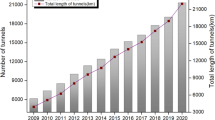Abstract
As more and more deep-buried metro stations appear, it’s becoming more and more difficult for people in the station hall and on the platform to evacuate in an emergency in these deep-buried stations. If people in the station hall choose to evacuate to the outside when fire happens in a underground station hall, the spread direction of the smoke is in coincident with the evacuation direction, which is unfavorable for the evacuation as well as the rescue from outside. Is it possible to use the platform as a shelter when the station hall catch fire? In this paper, the numerical method was used to demonstrate the feasibility of downward evacuation under the condition that fire happens in the station hall. At first, safety evacuation criteria were made to judge the feasibility of evacuation. Then, numerical models were established by FDS software, the smoke movement, the temperature, the concentration of carbon monoxide, and the visibility were taken into consideration to demonstrate the feasibility of downward evacuation. Different locations, different heat release rate of fires in the station hall were also calculated and analyzed. Results show that the downward evacuation to the platform is feasible during a fire in the station hall under the condition that the smoke exhausting system in the station hall can work properly and has enough efficiency.















Similar content being viewed by others
References
Moodie, K.: The King’s cross fire: damage assessment and overview of the technical investigation. Fire Saf. J. 18, 13–33 (1992)
Shi, C., Maohua, Z., Xingzhong, N., Jiehong, S., Guoguan, F.: Modeling and safety strategy of passenger evacuation in a metro station in China. Saf. Sci. 50, 1319–1332 (2012)
He, L., Liang, Q., Fang, S.: Challenges and innovative solutions in urban rail transit network operations and management: China’s Guangzhou metro experience. Urban Rail Transit. 2(1), 33–45 (2016)
Hong, W.-H.: The progress and controlling situation of Daegu subway fire disaster. In: Sixth Asia-Oceania Symposium on Fire Science and Technology, Daegu, Korea, Mar, pp. 17–20 (2004)
Fridolf, K., Nilsson, D., Frantzich, H.: Evacuation of a metro train in an underground rail transportation system: flow rate capacity of train exits, tunnel walking speeds and exit choice. Fire. Technol. 52(5), 1481–1518 (2016)
Zhong, M., Shi, C., Xuwei, T., et al.: Study of the human evacuation simulation of metro fire safety analysis in China. J. Loss Prev. Process Ind. 21, 287–298 (2008a)
Gao, J.X., Shi, C.L., Zhong, M.H.: Smoke control design of deep buried metro station. Journal of Safety Science & Technology. 6, 39–44 (2006) (In Chinese)
Zhong, M., et al.: Reliability analysis on platform fire smoke control in deep buried island metro station. In: The 2008 International Symposium on Safety Science and Technology (2008b)
Ministry of Construction of the People’s Republic of China. Chinese Code for Design of Metro (GB 50157-2003), National Standard of China. (2003) (In Chinese)
Zarboutis, N., Marmaras, N.: Searching efficient plans for emergency rescue through simulation: the case of a metro fire. Cogn. Tech. Work. 6, 117–126 (2004)
Kuligowski, E.D.: Human behavior in fire. In: SFPE Handbook of Fire Protection Engineering, pp. 2070–2114. Springer New York (2016)
Shi, C., et al.: Train fire smoke control in deep buried island metro station. The 2008 international symposium on safety science and technology (2008)
Zhong, M., Weicheng, F., Tiemin, L.: Safety evaluation of engineering and construction projects in China. J. Loss Prev. Process Ind. 16, 201–207 (2003)
National Fire Protection Association (NFPA 130, 2014). Standard for Fixed Guideway Transit and Passenger Rail Systems. Quincy, USA (2014)
Milke, J.A.: Evaluating the early development of smoke hazard from fires in large spaces. ASHRAE Trans. 106(1), 627–636 (2000)
Jin, T., Yamada, T.: Irritating effects of fire smoke on visibility [J]. Fire Science & Technology. 5(1), 2159–2164 (1985)
McGrattan K., et al.: Fire Dynamic Simulator User’s Guide, Sixth Edition. National Institute of Standard and Technology, Gaithersburg, Maryland, USA. NIST Special Publication 1019 (2015)
Hansell, G.O., Morgan, H.P.: Design approaches for smoke control in atrium buildings. Buildings research establishing report (BR- 258). UK (1994)
Heskestad, G., Delichatsios, M.A.: The initial convective flow in fire. Fire Saf. J. 15(6), 471–475 (1989)
Acknowledgements
The authors would like to thank the funding from the Ministry of Science and Technology of P.R.China (National Key R&D Program of China. No. 2016YFC0802500). Heng Yu also would like to say thanks to the China Scholarship Council for its financial aid.
Author information
Authors and Affiliations
Corresponding author
Additional information
Publisher’s Note
Springer Nature remains neutral with regard to jurisdictional claims in published maps and institutional affiliations.
Rights and permissions
About this article
Cite this article
Yu, H., Wang, Y., Qiu, P. et al. Study on the Feasibility of Downward Evacuation in a Metro Station when the Station Hall Catch Fire. Int. J. ITS Res. 18, 195–203 (2020). https://doi.org/10.1007/s13177-019-00191-4
Received:
Accepted:
Published:
Issue Date:
DOI: https://doi.org/10.1007/s13177-019-00191-4




